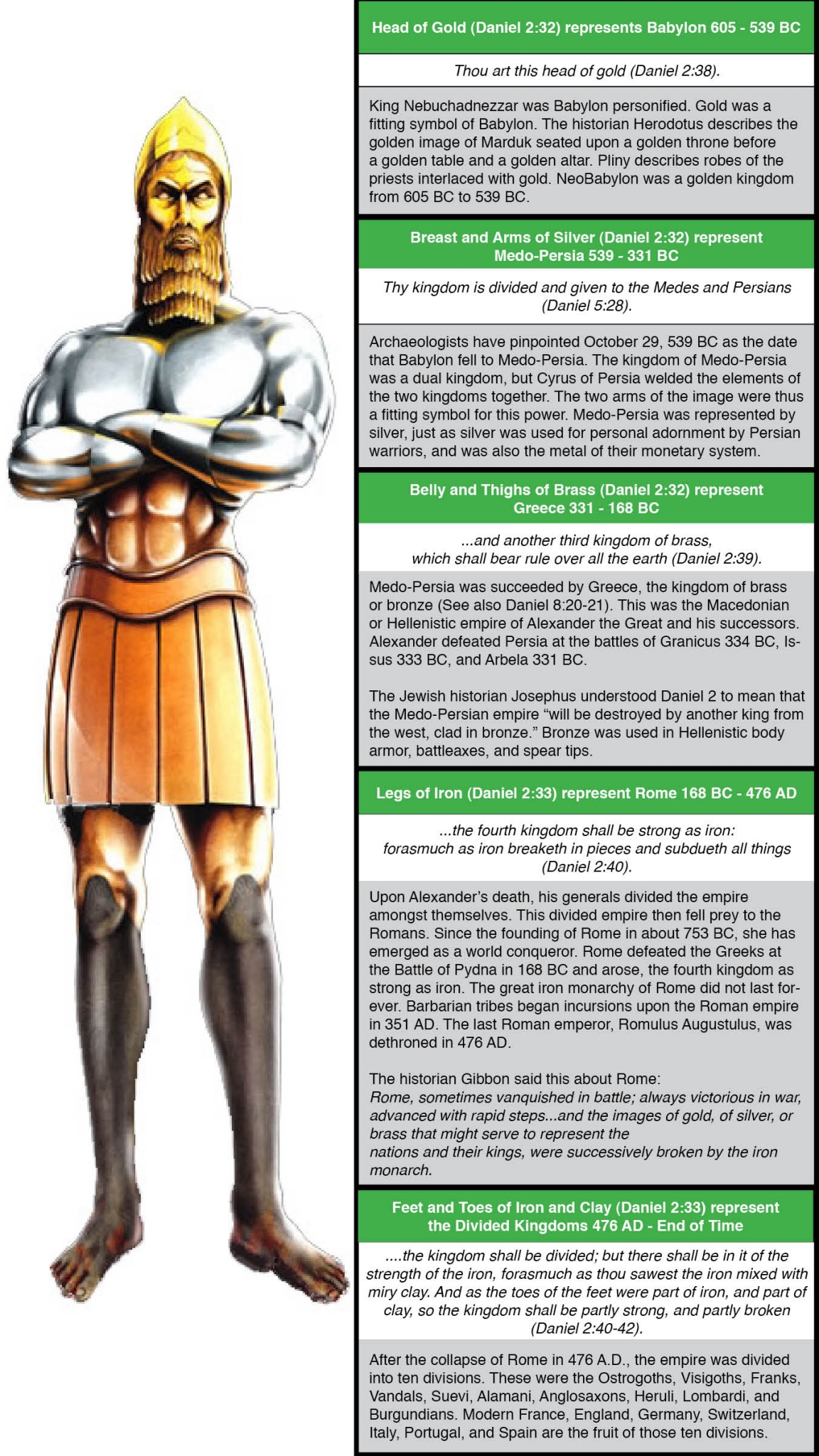One Column Page
and responsive to boot
Daniel's Fourth Beast
by Adam Maarschalk
This article appeared in the
2021 Winter issue of Fulfilled! Magazine
For about 650 years (586 BC – AD 70), Israel was subjugated by an unbroken chain of four empires. This is what I was taught, in any case, but is it true? Daniel’s four beasts have been interpreted in various ways, but one indisputable fact is that the fourth beast’s demise would coincide with Christ’s coming in judgment when the saints would possess the kingdom (Dan 2:44; 7:18, 22, 27 NKJV).
What light does this fact shed on the identity of the fourth beast? In the Fall 2021 issue of Fulfilled! Magazine, I gave eight reasons—seven from the book of Revelation—why I believe Israel was the beast. In this article, I will present seven reasons why I believe the book of Daniel reveals the same.
1. The fourth kingdom was in its final stage when it was crushed. In Nebuchadnezzar’s dream, it is important to note that the image was described progressively from head to toe, not vice versa. Thus, chronologically, the fourth kingdom was the “legs of iron” and “feet partly of iron and partly of clay.” It was the final stage of an image which transitioned [a] from gold [b] to silver [c] to bronze [d] to iron and to iron/clay. It consisted of [a] a head [b] a chest and arms [c] a belly and thighs [d] and legs and feet (Dan 2:31-35).
What part of the statue was struck and shattered by a stone (v. 34; Matt 21:44) which would become a great mountain and fill the whole earth (v. 35)? It was the feet, the final stage.
Rome became an empire in 27 BC, reached its height in AD 117,1 and endured until AD 476. Clearly, Rome was not in its final stage when the kingdom of God was set up in the first century.
Israel, on the other hand, was crushed by the stone in the Jewish-Roman War of AD 66-73. During that time, Christ came in judgment and established His kingdom, which has been in the hands of the saints ever since.
2. Daniel’s description of the third kingdom ends, not when Rome became an empire, but when Israel became independent.
The third kingdom is depicted in Daniel 2:32, 39 as the statue’s belly and thighs of bronze, and the third beast is depicted in Daniel 7:6 as a leopard with four wings and four heads, corresponding to the four generals of Alexander the Great. This third beast is described in greater detail in Daniel 8:5-14 and 8:21-26, and is explicitly identified in v. 21 as Greece. When Gabriel narrated the rise of Antiochus Epiphanes, and his downfall in 164 BC (Dan 8:21-26), he referred to this period as “the latter time of their kingdom” (v. 23; cf. Dan 8:17, 19). Note that Daniel’s vision didn’t continue beyond that time.
In Daniel 11:5-31, the reader learns of a series of battles between the Ptolemaic/Egyptian kings of the south and the Seleucid/Syrian kings of the north from ca. 323 BC – 164 BC. Daniel 11 also does not describe Greece beyond the time of Antiochus Epiphanes. As in Daniel 8, no transition from Greece to Rome is depicted in Daniel 11.
By way of comparison, the transition from the first kingdom (Babylon) to the second kingdom (Medo-Persia) is described in Daniel 5:30-31. Likewise, the transition from the second to the third kingdom (Greece) is described in Daniel 8:1-7.
It seems to be assumed by many that Daniel does somewhere depict Rome’s conquest of Greece. Consider the popular image on this page used by numerous online ministries.
It would seem fitting to find such a conquest in either Daniel 8 or Daniel 11, since Macedonia was established as a province of the Roman republic in 146 BC, but it’s not there.
On the other hand, scholars recognize that Daniel 11:32-35 speaks of the Maccabees, and v. 32 implies that they rise up in victory against Antiochus Epiphanes. What if this has everything to do with the transition from the third kingdom (Greece) to the fourth kingdom? At the very time when the book of Daniel ceased to speak of the Greek empire, and about 135 years before Rome became an empire, something amazing happened to Israel. Led by the Maccabees, Antiochus Epiphanes was defeated in 164 BC, and soon Judea was freed from the control of the Seleucid (Greek) Empire. In 142 BC, Israel became fully independent from Greece/Macedonia and was under no one’s dominion at all. As I Maccabees 13:41-42 records, “the yoke of the Gentiles was taken off from Israel.” Josephus likewise states that Simeon Maccabee “freed the Jews from the dominion of the Macedonians” (Wars 1.2.2). Instead of taking the baton from Greece and continuing Israel’s subjugation, Rome sent letters of congratulations to Israel, establishing an alliance and friendship with her (I Macc 14:4-24).2 Israel’s independence lasted for about 80 years, until 63 BC when Pompey the Great intervened in a Judean civil war and made Israel a client state of the Roman Republic. 3. Israel’s history fits Daniel’s transition from “iron” to “iron and clay.” In Daniel’s interpretation, the fourth kingdom would at first be as strong as iron, but later partly strong and partly fragile (Dan 2:40-43). I believe Israel’s period of independence (142 BC – 63 BC) was the iron part of the statue (the legs), and Israel’s period of semi-autonomy was the iron/clay part of the statue (the feet). 4. The Maccabees were known for striking hammer blows against their enemies, reminiscent of Daniel 7:7. In Daniel’s vision of the fourth beast, he saw that “it was devouring, breaking in pieces, and trampling the residue with its feet” (Dan 7:7). I believe the imagery of “breaking in pieces” corresponds to what is known about the Maccabees or the Hasmoneans. The family of the high priest, Mattathias, who helped lead the revolt against the Hellenistic Seleucid Empire, became known as the Maccabees. This name came from the Hebrew word for “hammer” because they gained a reputation for striking hammer blows against their enemies, thereby breaking them.3 The Maccabean/Hasmonean Dynasty ruled over Israel from 164 BC – 37 BC before giving way to the Herodian Dynasty. 5. Israel was divided shortly after losing its full independence, reminiscent of Daniel 2:41. This is what Daniel 2:41 states about the final stage of Nebuchadnezzar’s image: “Whereas you saw the feet and toes, partly of potter’s clay and partly of iron, the kingdom shall be divided; yet the strength of the iron shall be in it, just as you saw the iron mixed with ceramic clay.” Almost a decade after the invasion of Pompey the Great in 63 BC, a major division took place in 57-55 BC when the proconsul of Syria, Aulus Gabinius, divided the Hasmonean kingdom into five parts. As Josephus records in Antiquities 14.5.4, when Gabinius “had ordained five councils, he distributed the nation into the same number of parts. So these councils governed the people; the first was at Jerusalem, the second at Gadara, the third at Amathus, the fourth at Jericho, and the fifth at Sepphoris in Galilee.” 6. Israel was slain and burned, fulfilling Daniel 7:11. “I watched then because of the sound of the pompous words which the horn was speaking; I watched till the beast was slain, and its body destroyed and given to the burning flame.” The language in this verse certainly fits Israel, considering that Israel was destroyed in the Jewish-Roman War of 66-73, and Jerusalem and the temple were burned with fire (fulfilling Matt 22:7; 2 Peter 3:7, 10, 12; Rev 17:16; 18:8-9, 18; 19:20). This does not fit Rome, which was not slain, destroyed, or burned when the kingdom of God was given into the hands of the saints (Dan 2:35, 44; 7:18, 22, 27; Matt 16:27-28, 21:43; Rev 11:15). The language of Daniel 7:11 also doesn’t describe Rome’s eventual downfall in AD 476. 7. Israel was different than the first three kingdoms (Daniel 7:7, 23). Daniel 7 twice describes the fourth beast as being unique: “. . . The fourth beast shall be a fourth kingdom on earth, which shall be different from all other kingdoms . . . . It was different from all the beasts that were before it . . .” (Dan 7:7, 23). Like the first three kingdoms, the Maccabees expanded their territory by political conquest, including the territory later named the Decapolis, which in 63 BC “welcomed Pompey as a liberator from the Jewish Hasmonean kingdom.”4 However, unlike the other kingdoms, the Hasmonean kingdom also expanded through forced religious conversions.5 I believe the primary distinction was Jerusalem’s religious authority over the Jewish diaspora. Israelites living far beyond the land of Israel were subject to Jerusalem’s authority. The high priesthood in Jerusalem held authority over Jews living in “every nation under heaven” (Acts 2:5). For more details about the beast from this perspective, my ongoing series on the beast can be found at the following link: adammaarschalk.com/beast-of-revelation/.1 For more details, see https://www.vox.com/world/2018/6/19/17469176/roman-empire-maps-history-explained (particularly map #4). 2 For more details, see https://adammaarschalk.com/2017/01/10/rome-congratulated-israel-on-becoming-the-fourth-kingdom-of-daniel-2/. 3 For more details, see the book of I Maccabees and https://www.jewishvirtuallibrary.org/history-and-overview-of-the-maccabees. 4 For more details, see https://en.wikipedia.org/wiki/Decapolis. 5 For more details, see https://en.wikipedia.org/wiki/Maccabees.
Comments:
Your honest review will help others in their search for truth. If you must leave a negative review please be gracious.
Rather, speaking the truth in love, we are to grow up in every way into him who the head, into Christ . . . .
(Ephesians 4:15)
We use "Disqus" commenting software. If you are not familiar with "Disqus," click here for more information. You don't need a Disqus account to post comments, however, without an account you won't be notified if someone responds to your post.
 Fulfilled
Fulfilled